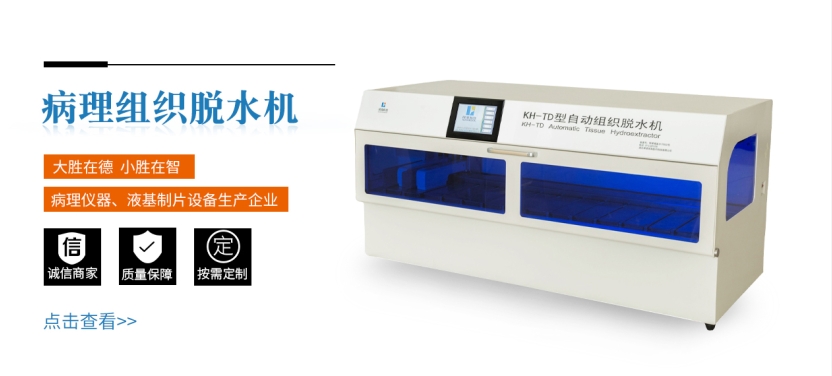Pathological Technology Sharing - Dehydration and Transparency
Time:2023-10-27
Dehydration refers to the use of dehydrating agents to replace the water inside the tissue, in order to facilitate the infiltration of organic solvents. This process is called dehydration.
Whether dehydration is complete or not directly affects whether the organization can be fully transparent, while insufficient or excessive dehydration (which is not usually possible at this time in daily work) can easily lead to tissue fragility. The reasons for tissue embrittlement include heating (over 36 ℃), adding acetone to the dehydrating agent, and excessive xylene in the paraffin used for wax immersion.

KH-TD Biological Tissue Intelligent Dehydrator
We generally believe that tissue embrittlement is related to high concentration alcohol, while neglecting the relationship with low concentration alcohol. In fact, low concentration alcohol has strong penetration power and is easier to penetrate into tissue blocks than pure alcohol to dehydrate. If the tissue is fully dehydrated in low concentration alcohol, it only needs to remove the water from low to high concentration in high concentration alcohol, so it can be completed in a short time.
The so-called excessive dehydration causing tissue embrittlement may be caused by excessive initial dehydration concentration. If heated during dehydration and acetone is used, it can also cause tissue contraction and affect immunohistochemical labeling. In order to immerse paraffin into tissue blocks, it must pass through a medium that can be mixed with dehydrating agents and soluble with paraffin, and this process is called transparency. The best transparent agent currently is xylene. Many people believe that xylene can easily cause tissue embrittlement, which is a one-sided view. At room temperature, if it is not for a long time (over 24 hours), xylene will not cause excessive tissue embrittlement. On the contrary, it will make some tissues with relatively tough structures, such as uterine fibroids, which are quite easy to cut. However, when the temperature of xylene exceeds 36-40 ℃, it is very easy to cause tissue embrittlement. The optimal dehydration time (room temperature 18 ℃) is 2 hours for 80% alcohol, 1 and a half to 2 hours for 95% alcohol (2 courses), 1 and a half to 2 hours for pure alcohol (3 courses), and 30 to 60 minutes for xylene (2 courses). The length of dehydration time is closely related to the temperature. We have found in practice that room temperature between 12 and 15 ℃ can serve as a critical temperature range. When the room temperature is higher than this temperature range, the tissue is prone to dehydration, and the dehydration time can be appropriately shortened; When the room temperature is below this temperature range, the dehydration time should be appropriately extended (if it can be ensured that it is optimal at a constant temperature). The replacement of reagents should be based on quantity, quantitative replacement, and cannot wait until the slicing is poor before replacement. Otherwise, at least 2-3 batches of tissue slices will be poor. Based on our experience, if the reagent dosage is 500ml, it is advisable to replace every 500 wax blocks.




 鄂公网安备42090202000178号
鄂公网安备42090202000178号